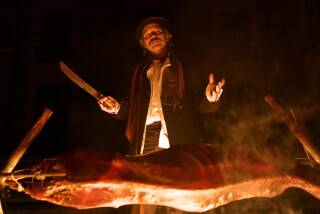Classic Hollywood: A silent revolution in âFilms of 1912â
Even in 1912, movies audiences had their favorite stars.
Like Maurice Costello, the great-grandfather of Drew Barrymore. In the lighthearted âThe Picture Idol,â a devoted fan canât stop following him. So Costello sets up a clever ruse of introducing the female admirer to a phony wife and child so she will leave him alone.
âThe Picture Idolâ is one of the many films screening during the Academy of Motion Picture Arts and Sciencesâ program âA Century Ago: The Films of 1912â Thursday evening at the Linwood Dunn Theater in Hollywood.
Michael Mortilla will provide live musical accompaniment on the piano while the films are presented on a 1909 hand-cranked Powerâs Model 6 Cameragraph Motion Picture Machine, restored and cranked by Joe Rinaudo.
PHOTOS: Behind-the-scenes Classic Hollywood
Thursdayâs program also marks the 10th anniversary of the academyâs âA Century Agoâ series, created and hosted by Randy Haberkamp, the organizationâs managing director for programming, education and preservation.
Also screening are âIdaâs Christmas,â which stars Costelloâs young daughter, Dolores; D.W. Griffithâs âAn Unseen Enemy,â which marked the film debut of silent superstar Lillian Gish and her sister, Dorothy; the Mack Sennett comedy âAt Coney Islandâ; âBroncho Billy and the Schoolmistress,â with G.W. Anderson; the newsreel âLos Angelesâ and a comedy called âCanine Sherlock Holmes,â starring a Jack Russell terrier whom Haberkamp says âgives Uggie a run for his money.â
The movies came from the Academy Film Archive, the Library of Congress, the Museum of Modern Art, the Nederlands Film Museum and UCLA Film and Television Archive.
Movies started to grow up in 1912. Films began to expand from one-reel shorts to one-hour features. More production moved from New York, New Jersey and Chicago to the West Coast, and directors such as Griffith were expanding the cinematic language through innovative editing and the use of close-ups and location shooting.
âThey were being influenced by some of the Italian and French epics that were being produced,â Haberkamp said.
And filmmakers realized movies were a way to implement social change.
âThere was a lot of social consciousness going on,â Haberkamp said. âSome films were being commissioned by people who were interested in homelessness in Chicago or child labor. There was certainly an awareness of using social themes to attract a more intellectual crowd and also to affect change â to use movies to educate in a more popular sense. Before, movies had been much more a part of vaudeville â a curiosity. People were really taking movies seriously at this point.â
Even the way movies were exhibited changed. Nickelodeons were disappearing.
âTheaters were really starting to get much more sophisticated, much larger and going less from a kind of storefront feel,â Haberkamp said.
âTheaters were being built all over the country,â he noted. âThey were what we would think of now as a neighborhood theater.â
Women were involved in filmmaking. Alice Guy-BlachĂŠ and Lois Weber were directing. Famed writer Anita Loos (âGentlemen Prefer Blondesâ) penned her first screenplay, âThe New York Hat,â starring Mary Pickford and directed by Griffith. Gene Gauntier was starring and writing movies for the Kalem Co., including âFrom the Manger to the Cross,â shot on location in Palestine.
Filmmakers and audiences were tired of stage-bound plots shot against painted backdrops.
âThere was much more a sense of real-life locations,â Haberkamp said. âWesterns were very popular, and people were looking for more authenticity.â
So there was a rapid expansion in 1912 of studios in Los Angeles.
âIt had gone from being one studio to a dozen or more,â he said. âThere was a lot of activity.â
For more information, go to https://www.oscars.org.
Are you an aficionado of iconic Hollywood? Like our Classic Hollywood Facebook page to get more Times coverage.
PHOTOS AND MORE
VIDEO: Highlights from the Envelope Screening Series
The Envelope: Awards Insider
PHOTOS: NC-17 movies: Ratings explained
More to Read
Only good movies
Get the Indie Focus newsletter, Mark Olsen's weekly guide to the world of cinema.
You may occasionally receive promotional content from the Los Angeles Times.











